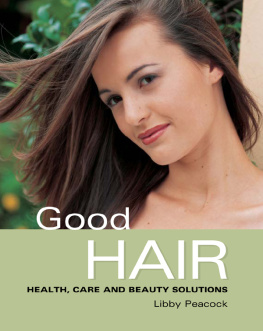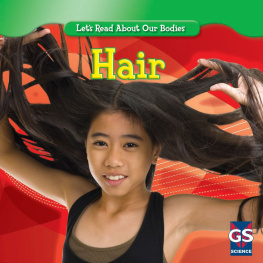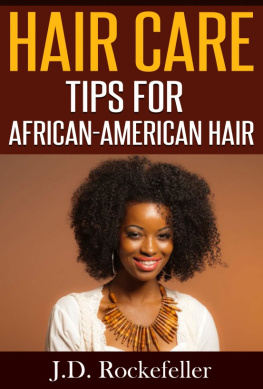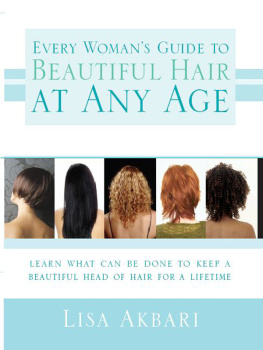Contents
Guide
LIBBY PEACOCK is a journalist who specializes in health and lifestyle issues. She started her career as a staff reporter for a major South African newspaper, before moving on to become a features writer for a national womens magazine. Her career then took her to Dubai, where she worked as deputy editor for a glossy English-language womens magazine, and to Hong Kong, where she spent three years working as staff editor for a number of publications.



First published in 2005 by
New Holland Publishers
London Cape Town Sydney Auckland
www.newhollandpublishers.com
86 Edgware Rd
London W2 2EA
United Kingdom
14 Aquatic Drive
Frenchs Forest, NSW 2086
Australia
80 McKenzie Street
Cape Town 8001
South Africa
218 Lake Road
Northcote, Auckland
New Zealand
Copyright 2005 New Holland Publishers (UK) Ltd
Copyright 2005 in text: Libby Peacock
Copyright 2005 in illustrations: James Berrang
Copyright 2005 in photographs: New Holland Image
Library (NHIL/Micky Hoyle), with the exception of the indi-vidual photographers and/or their agents as listed on p91).
All rights reserved. No part of this publication may be reproduced, stored in a retrieval system or transmitted, in any form or by any means, electronic, mechanical, photocopying, recording or otherwise, without the prior written permission of the publishers and copyright holders.
Publisher: Marille Renssen
Publishing managers: Claudia Dos Santos, Simon Pooley
Commissioning editor: Alfred LeMaitre
Studio manager: Richard MacArthur
Editor: Katja Splettstoesser
Designer: Elmari Kuyler
Illustrator: James Berrang
Proofreader: Leizel Brown
Picture researchers: Karla Kik, Tamlyn McGeean
Production: Myrna Collins
Consultant: Beryl Barnard FSBTh. M.PHYS. ATT,
Education Director, The London School of Beauty and Make-up
ISBN 1 84330 763 4 (HB); 1 84330 764 2 (PB)
Reproduction by Hirt & Carter (Cape) Pty Ltd
Printed and bound in Malaysia by Times Offset (M) Sdn. Bhd.
10 9 8 7 6 5 4 3 2 1

DEDICATION
This book is dedicated to all my wonderful friends. Thank you for helping me through the bad hair days!
DISCLAIMER
The author and publishers have made every effort to ensure that the information contained in this book was accurate at the time of going to press, and accept no responsibility for any injury or inconvenience sustained by any person using this book or following the advice provided herein.
ACKNOWLEDGEMENTS
With special thanks to: Dr Sue Jessop (senior specialist and lecturer, division of Dermatology, Groote Schuur Hospital and University of Cape Town), for advising on and checking the medical sections in Good Hair. Dr Larry Gershowitz and the Medical Hair Restoration Clinic in Cape Town for up-to-date information on hair transplants. Dermatologist Dr Ian Webster for information on hair-removal methods and the pros and cons of laser hair removal in particular. Julia Lovely, dietician in private practice in Cape Town, for information on the impact of diet on hair. Tony Martin of Yazo4Hair salon, for parting with expert tips on hairstyling for men and women, and for top colouring advice. Dima Tsobanopulos of D&D Designers for Hair for styling tips, and information on face shapes and the latest straightening techniques. Carlton Skincare Centre, Constantia, Cape. Skincare therapist Gerda van Rooyen for the latest on hair removal and Ellen Nwenesongole of Procter & Gamble SA (Pty) Ltd, for reference material on hair and hair products.
contents


Hair as we know it
The English language is rich in hair-related expressions, for good reason: our hair is not only useful, it also reflects who we are. So, when we nitpick about small things, we split hairs; when we have a narrow escape, we escape by a hairs breadth; and when we have a good time, we let our hair down.
Hair gives away clues about our personalities and carries cultural connotations. Pious Christian nuns cover their hair. Muslim women wear headscarves to hide theirs from the eyes of all men but their husbands and immediate family. In India, hair is regarded as one of the most important aspects of feminine beauty. In some faiths, hair is cut during mourning. Several ancestral cultures still believe hair has magical powers; even in modern European countries some parents keep locks of their babies hair.
Legends abound about hair: when Biblical hero Samsons long hair was cut, he lost his power; and, while blondes have more fun, redheads are believed to have a fiery temperament. Thankfully, many of these perceptions are not scientifically supported!
Assuming about 80 per cent of scalp hairs are in the active growth phase at any given time, a human produces about 9km (5.6miles) of hair every year.

Your hairs structure
Given that healthy hair is a reflection of ones general health, it is ironic that the visible part of a hair the hair shaft is physiologically speaking, dead, with only the tiny part underneath the scalp (the root or dermal papilla) consisting of living hair-forming cells known as trichocytes and keratinocytes. The dermal pa-pilla, nourished by a network of blood vessels and nerves, is nestled in a tubelike hair follicle and surrounded by what is known as the bulb. The bulb is embedded about 4mm (0.2in) in the subcutaneous fat of the scalp. The outer layers of the hair bulb are known as the outer and inner root sheaths. It is in the dermal papilla that most hair growth takes place. In order for hair to grow, cells have to reproduce. This takes place around the dermal papilla in what scientists call the zone of proliferation.
Each hair has a protective outer cuticle, made up of tiny overlapping scales, often compared to miniature roof tiles, and a thick cortex that lies under the cuticle and consists of the protein keratin. Keratin is also found in human skin and nails, as well as in the feathers, claws, hooves and wool of birds and animals.
Hair also contains the elements carbon, oxygen, nitrogen and sulphur and a tiny percentage of the trace elements zinc, iron, copper and iodine. Other components include fats, and water, which makes up about 12 per cent of a hairs weight.
Some types of hair particularly thick, dark hair also have a central medulla, which when inspected under an optical microscope, looks a little like a central canal. Some scientists believe it enhances the thermal-insulation properties of hair. Others speculate that the medulla carries nutrients to the cuticle and cortex, while yet another theory is that it contributes to the shine of hair.














